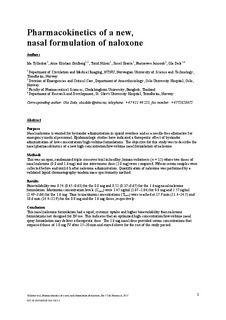| dc.contributor.author | Tylleskär, Ida | |
| dc.contributor.author | Skulberg, Arne Kristian | |
| dc.contributor.author | Nilsen, Turid | |
| dc.contributor.author | Skarra, Sissel | |
| dc.contributor.author | Jansook, Phatsawee | |
| dc.contributor.author | Dale, Ola | |
| dc.date.accessioned | 2017-05-22T08:31:25Z | |
| dc.date.available | 2017-05-22T08:31:25Z | |
| dc.date.created | 2017-02-09T10:40:20Z | |
| dc.date.issued | 2017 | |
| dc.identifier.issn | 0031-6970 | |
| dc.identifier.uri | http://hdl.handle.net/11250/2443082 | |
| dc.description.abstract | Purpose
Nasal naloxone is wanted for bystander administration in opioid overdose and as a needle-free alternative for emergency medical personnel. Epidemiologic studies have indicated a therapeutic effect of bystander administration of low-concentration/high-volume formulations. The objective for this study was to describe the nasal pharmacokinetics of a new high-concentration/low-volume nasal formulation of naloxone.
Methods
This was an open, randomized triple crossover trial in healthy, human volunteers (n = 12) where two doses of nasal naloxone (0.8 and 1.6 mg) and one intravenous dose (1.0 mg) were compared. Fifteen serum samples were collected before and until 6 h after naloxone administration. Quantification of naloxone was performed by a validated liquid chromatography-tandem mass spectrometry method.
Results
Bioavailability was 0.54 (0.45–0.63) for the 0.8 mg and 0.52 (0.37–0.67) for the 1.6 mg nasal naloxone formulation. Maximum concentration levels (Cmax) were 1.45 ng/ml (1.07–1.84) for 0.8 mg and 2.57 ng/ml (1.49–3.66) for the 1.6 mg. Time to maximum concentrations (Tmax) were reached at 17.9 min (11.4–24.5) and 18.6 min (14.4–22.9) for the 0.8 mg and the 1.6 mg doses, respectively.
Conclusion
This nasal naloxone formulation had a rapid, systemic uptake and higher bioavailability than naloxone formulations not designed for IN use. This indicates that an optimized high-concentration/low-volume nasal spray formulation may deliver a therapeutic dose. The 1.6 mg nasal dose provided serum concentrations that surpassed those of 1.0 mg IV after 15–20 min and stayed above for the rest of the study period. | nb_NO |
| dc.language.iso | eng | nb_NO |
| dc.publisher | Springer Verlag | nb_NO |
| dc.relation.uri | http://rdcu.be/oW0B | |
| dc.title | Pharmacokinetics of a new, nasal formulation of naloxone | nb_NO |
| dc.type | Journal article | nb_NO |
| dc.type | Peer reviewed | nb_NO |
| dc.source.journal | European Journal of Clinical Pharmacology | nb_NO |
| dc.identifier.doi | 10.1007/s00228-016-2191-1 | |
| dc.identifier.cristin | 1448784 | |
| dc.description.localcode | This is the authors' accepted and refereed manuscript to the article. Locked until 31 january 2018 due to copyright restrictions. The final publication is available at Springer via http://dx.doi.org/10.1007/s00228-016-2191-1 | nb_NO |
| cristin.unitcode | 194,65,25,0 | |
| cristin.unitname | Institutt for sirkulasjon og bildediagnostikk | |
| cristin.ispublished | true | |
| cristin.fulltext | postprint | |
| cristin.qualitycode | 2 | |
